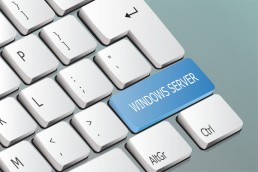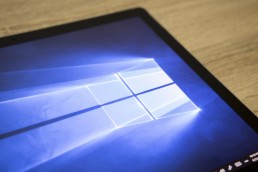Windows Server 2019: Important innovations at a glance
Windows Server 2019: An overview of important new features
Better container support, optimised interaction with Azure and easier encryption. Here's a look at the best new features in the upcoming Windows Server 2019.
Windows Server 2019 comes with a wealth of new features. Collaboration with Microsoft Azure is improved, container technology is significantly expanded and Linux finds broad support. File servers with Windows Server 2019 can also be operated much more effectively and migrations can be carried out more easily. We give a preview of the ten best new features.
All the new features from Windows Server 1709/1803
Windows Server 2019 will include all the new features from the semi-annual versions Windows Server 1709 and Windows Server 1803. These include optimised container management, better Storage Spaces Direct, expanded support for Linux and more. There’s also the added benefit of Windows Server 2019 getting a graphical interface to make the new features easier to manage.
New container image with almost complete Windows server
With Windows Server 2019, Microsoft provides a new container image with the current name „windows“. In addition to the two images „nanoserver“ and „windowsservercore“, the „windows“ image is supposed to have a greatly expanded range of functions with which almost all Windows programmes can be used. This means that developers can also run apps in containers with which this is currently not possible.
Kubernetes support and better containers
In general, Microsoft wants to improve the work with containers with Windows Server 2019. Windows Server 2019 will work directly with Kubernetes so that hybrid container environments can also be operated. The individual images for containers will be improved. For example, the core image will be further reduced in size, the nano image will be expanded, and collaboration between containers will be optimised.
Better virtualisation of Linux servers
Linux servers can be virtualised better with Windows Server 2019. In addition, Linux servers can be secured with shielded VMs in Windows Server 2019. This is currently only possible with Windows servers. In general, Linux will connect better with Windows Server 2019.
Windows Subsystem for Linux
The Windows Subsystem for Linux enables the integration of a Linux distribution within a Windows installation. This allows Linux servers to be managed directly from Windows servers using Linux commands. Windows servers can thus also be administered via Linux commands. This improves cooperation between Linux and Windows enormously. Numerous distributions are to be added in Windows Server 2019.
Windows Defender Advanced Threat Protection (ATP)
Windows Server 2019 works directly with Windows Defender Advanced Threat Protection. This is an advanced attack protection that works without signature files and can detect zero-day attacks and root kits. The service has cloud connectivity and reliably detects attacks that are not detected by virus scanners. ATP does not replace anti-malware scanners, but complements them.
Better encryption
In Windows Server 2019, data can be encrypted easier and better. Network traffic can also be encrypted better in Windows Server 2019. This also applies to virtual machines.
Storage migration wizard from numerous sources
The new Storage Migration Service helps migrate file servers and the data to Windows Server 2019. The wizard can also move data from NAS systems, works with Microsoft Azure, and can transfer data and permissions quickly and easily. The target can be servers running Windows Server 2019, and the source can be a whole range of devices. Migrating to Windows Server 2019 should be easier than ever for this reason.
Better integration with Microsoft Azure
Windows Server 2019 works more closely with Microsoft Azure. Data can be synchronised between Azure and Windows Server 2019, data can be backed up with Azure Backup, and file servers can be populated with data from the cloud via Azure Files. Clusters can be connected to Microsoft Azure, and the aforementioned Storage Migration Wizard can also import data from the cloud or back up data to the cloud.
New express updates
Windows 10 computers and current Windows servers, as well as Windows Server 2019, will benefit from the new Express Updates. Express Updates are much smaller than the current Cumulative Updates and Delta Updates, which only reload missing updates. Express updates work much like backups that build on each other and can be downloaded and installed much faster. It also significantly reduces the number of reboots.
Header image: © AliFuat, stock.adobe.com
Installation of ISO files & activations of (Office 2013, 2016 & individual applications Word, Excel, Powerpoint etc.)
- Click on„Install now“ to install all office applications or customise the installation by clicking on„Customise„.


- Installation has been completed successfully, click on „Close“
Activating Office
- Start any Office application (e.g. Word) and open an empty document.
- Now click on „File“ in the top left-hand corner and then on „Account“.
- Now you will find the option on the right under „Product Information“ to enter the key you received from us there under „Change Product Key“.
- Then enter the product key and click on “ Install“ to complete the activation.


Header-Bild: © monticellllo, stock.adobe.com
Manually make USB stick bootable/ prepare UEFI USB stick
Diskpart - Manually make USB stick bootable/ Prepare UEFI USB stick
Prepare UEFI USB stick
Create a new primary partition on the USB stick using Diskpart, format it with the FAT32 file system and assign a drive letter. To do this, execute the following commands:
diskpart list disk select disk # clean create partition primary select partition 1 active format quick fs=fat32 assign exit

Copy Windows installation files to the USB stick
Next, the Windows installation files must be copied to the USB stick. You can do this simply by using Copy – Paste. It does not matter whether you have mounted an ISO image in Windows, unpacked it or inserted an installation DVD. If the install.wim file of the Windows image is larger than 4GB, an error will occur during the copying process. At the end of the copying process, a message will appear stating that the file is too large. This message appears because the FAT32 file system has reached its limits and cannot process >4GB files. To still be able to complete the UEFI USB stick, you have to use a little trick: Using DISM, the file must be split into two or more <4GB files. Please note that this procedure is only supported by Microsoft up to Windows 7 or Windows Server 2008.[3] [4] To do this, simply enter the following command:
-
Dism /Split-Image /ImageFile:E:sourcesinstall.wim /SWMFile:C:UsersAdministratorDesktopinstall.swm /FileSize:3000
- /ImageFile: Path of the source file install.wim in the sources folder of the Windows ISO
- /SWMFile: Path of the splitted target files
- /FileSize: maximum size of the splitted target files in MB

Now the splitted install.wim, install2.wim, install3.wim etc… can be copied to the USB stick in the „sources“ directory.
Fix error message status 0xc0000d
If you get the error message EFIMicrosoftBOOT\BCD status 0xc000000d when booting the USB stick, please check the following things:
- If it is a system with Secure Boot, disable Secure Boot.
- Select the USB stick (not Windows Boot Manager) in the boot menu.
Booting should work afterwards.
Header image: © PheelingsMedia, stock.adobe.com
You want to install Windows 10 on your PC? using Windows MediaCreationTool
You want to install Windows 10 on your PC? using Windows MediaCreationTool
Create bootable USB stick for Windows 10 from the Internet
If Windows 10 is available to you as an ISO file, the easiest way to create a bootable USB stick is based on Windows 7 or Windows 8 / 8.1 as well as Windows 10. Microsoft provides the ISO files of Windows 10 free of charge. You download the free MediaCreationTool from this page and run it. Then download the ISO files. To do this, select the option Create installation media for another PC.

If you have an ISO file of Windows 10, you can download an ISO for free from Microsoft using a tool.
02. Selecting the edition, language and architecture
On the next page of the tool , you then select the language you want, the edition you want to download and the architecture, i.e. 32-bit or 64-bit. The Enterprise Edition is not available via this route. If you want to create a bootable USB stick from it, you have to get the ISO file in another way.

In the MediaCreationTool you can download an ISO file with your desired edition if you wish.
03. Perform ISO download and select USB stick
In the next step, you can either copy the installation files immediately to a suitable USB stick or download the installation files as an ISO. This is the best way in most cases, as you can quickly and easily create a USB stick from the ISO at any time.

You can quickly and easily create an ISO file from the MediaCreationTool, or a bootable USB stick.
04. Finalise configuration
If you want to create a USB stick from the MediaCreationTool, it must now be connected to the computer. Then you can select which stick you want to use. The stick must have at least 4 GBytes of memory, preferably more. The wizard then downloads the Windows 10 installation files and copies them to the USB stick or to the ISO file.

In the Windows 10 Download Wizard, you can select a USB stick.
05. Creating a bootable USB stick from an existing ISO file
If you already have an ISO file of Windows 10, you can also create a bootable USB stick from Windows 7/8/8.1/10 using on-board tools. To do this, make the ISO file available as a drive via the context menu and start a command prompt with administrator rights. The USB stick must also be connected to the computer. Start a command prompt for this via the context menu in administrator mode. For example, enter cmd on the start page/start menu, click on the command prompt symbol that appears and click on Run as admin.

In Windows 8/8.1 and Windows 10, start the command prompt with administrative rights to create a bootable USB stick.
Header image: © rvlsoft, stock.adobe.com
Create screenshot (Windows 10)
Create screenshot (Windows 10)
This does not even require any other programmes to be downloaded and installed anywhere. Windows itself has programmes such as the „Snipping Tool“. Alternatively, screenshots can also still be provided with symbols and other coloured markings using tools such as „Paint“.
How to take a normal screenshot under Windows 10
If you want to take a screenshot of the current screen content, press the key combination “ Windows key + Print“. The image is now saved in the clipboard and can be pasted from there into a programme such as „Paint“. To do this, press the key combination „Ctrl + V“. If you use several monitors, a complete large image of all screens is created. Alternatively, to take a screenshot of the current active window, press the key combination „Alt+Print“. Again, the screenshot can be pasted into any programme with „Ctrl + V“
How to create a screenshot with the Snipping Tool
The Snipping Tool is an on-board Windows tool. If you want to take a screenshot quickly, it is best to call up the small programme in the Start menu by entering its name. After the tool has started, you can mark the area to be displayed in the screenshot with the mouse pointer. This is particularly advantageous if you only want to show individual small areas. After taking the screenshot, functions such as a highlighter, pen and eraser are available. Furthermore, the screenshot can also be saved or sent directly by e-mail with just one mouse click. Try it out for yourself.
Header image: © charnsitr, stock.adobe.com






